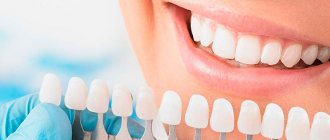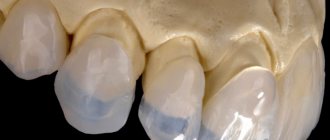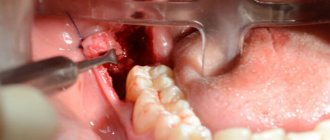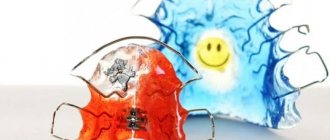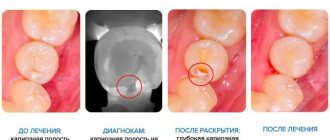What to do if your child has a pink tooth
The tooth consists of both hard and soft tissues. Inside it is soft pulp and nerves. The pulp is made up of a semi-solid material called dentin. Dentin helps form the bulk of the structure and protect the sensory nerves and blood vessels inside. Enamel is a thin coating over dentin that adds another layer of protection. Enamel helps protect dentin and pulp from bacteria. Caries that gets into the enamel and dentin and reaches the pulp can lead to its death. When decay reaches the pulp, it creates a pathway for bacteria to infect the tissue. A healthy pulp will respond to infection the same way as any other part of the body: with inflammation.
Another thing that can cause redness is injury. If you are struck in the jaw by a fall or while playing sports, it can damage blood vessels. The tooth needs blood, so when there is no more blood, it dies. This usually happens slowly over time and does not cause as much pain as when decay reaches the pulp.
During eruption, root resorption occurs. The root is absorbed and begins to dissolve. Once the root is completely resorbed, the baby tooth will fall out - so there will be no visible root. If resorption continues, a pink tint may appear. It may take about 2-3 weeks for the color to change. If the tooth turns red, this is the result of thinning or translucency of the enamel. This looks strange, but is not a cause for alarm. Parents can always consult a dentist if the child is bothered by pain or the shade becomes more intense.
The damage is usually irreversible, but sometimes it can be repaired, especially if it is caused by tooth decay. The dentist will make a diagnosis and recommend treatment.
Disease that causes stains on teeth
A dental disease that manifests itself in the form of multi-colored spots on their surface is called hypoplasia . The disease appears during the gestation period of the future dental patient. It develops in a child if the mother, during pregnancy, had stomach problems, and also had a lack of vitamin D or was exposed to a viral disease.
In such cases, it is necessary to increase the child’s immunity and change his diet. First of all, it is necessary to exclude the possibility of excessive amounts of fluoride entering the body. To do this, you should avoid toothpaste with a high content of it. You need to give your child only purified (bottled or filtered) water, and also give him more vitamins, vegetables and fruits.
With the development of the disease, expressed in the appearance of new spots and an increase in the area of existing ones, remineralization is necessary. The procedure consists of the dentist coating the teeth with a special paste containing substances designed to strengthen the enamel. For hypoplasia detected before the age of eighteen, fluoridation or silvering is also performed.
How to treat a pink tooth in a child
A pink tooth in a child should not cause panic. It is important to know that this is usually not a serious situation. The problem often occurs in young children and, as a rule, it is harmless - there is no harmful effect on the health of the jaw. A red tooth in a child is a sign of resorption.
If the pink discoloration is persistent, it may indicate a more serious problem and parents should consult a dentist.
The doctor can:
- put a seal;
- remove dentin;
- apply intracanal bleaching.
Treatment depends on various factors and the exact cause of the change in shade.
Treatment of stained teeth at the Family Dentist clinic
We have experienced doctors who have been treating caries and non-carious lesions for 15–20 years, and accurately identify the spotted form of hypoplasia. White spots on teeth are similar to early caries and fluorosis. We identify the disease by its shape, color intensity, localization of lesions, smoothness or roughness of the enamel layer. We dry the teeth, examine them under fluorescent lighting, and stain them with methylene solution.
Our pediatric dentists provide attention and care, treat restless and capricious little patients with patience, and make diagnosis and treatment comfortable. Children leave in a good mood and are not afraid to come again.
Dental hypoplasia is irreversible; treatment consists of strengthening the enamel layer and restoring chips, cracks, and color. We select treatment tactics depending on the severity of the disorders and take into account the condition of hard tissues.
We perform remineralizing therapy to strengthen the enamel and prevent caries at the site of the spots. We apply applications or mouth guards with preparations containing phosphorus and calcium. To increase the effectiveness of remineralization, after completing the course we fluoride the teeth to prevent calcium leaching. For hygiene, we recommend prophylactic pastes with fluorides, phosphates, hydroxyapatite crystals, and calcium. In Minsk there are good pastes: Apadent Kids, Children's Pearls, Lacalut Kids, Biorepair Kids.
We excise areas with erosion and install a filling if we are treating brown spots on children’s teeth. Our clinic uses reliable filling materials with fluoride, which are indistinguishable in shine and color from natural enamel. Filling prevents the appearance of cracks, the penetration of microbes, and gives the smile an aesthetic appearance.
We use whitening in older children with slight clouding of the enamel. Whitening methods are effective for isolated chalky stains.
If you notice white or brown spots on your child's teeth, make an appointment with our family dentistry. We will strengthen the enamel, restore damaged areas, and eliminate cosmetic defects.
What to do if an adult’s tooth turns red
As resorption occurs, the pink or red color becomes more noticeable and the structure changes. If you catch the early stage of dying, there is a chance to preserve the external structure. The internal, damaged pulp can be cleaned out and replaced with a hard filling material that will help protect the structural integrity. Preserving as much of the original structure as possible is important for oral health. Gaps in your smile can lead to poor jawbone health, uneven bites, bacterial growth, and cosmetic problems.
If severe damage is observed, removal will likely be the best option. It is recommended to get an implant to maintain the health of your jaw and mouth.
External discoloration
The reason is a pigmented plaque that forms on the roughness of the enamel, in microscopic cracks or anatomical cavities. Discoloration of teeth in this case is a consequence of consuming coloring products (tea, coffee, red wine, soda, etc.), smoking, and a reduced level of hygiene. Professional teeth cleaning at the dentist with mandatory enamel polishing, teaching the patient the rules of personal hygiene, and limiting the intake of coloring products will help get rid of it. In some cases, it is possible to use abrasive preparations.
Why does a filled tooth suddenly turn pink?
If dental treatment was successful, but the healed tooth hurts, this does not indicate any problems, but gives reason to consult a dentist. If the filled tooth turns pink, this may be the result of the fact that the paste contained resorcinol and formaldehyde. But most often the change signals pulpitis, periodontitis, traumatic injury or rupture of a vessel in the pulp.
If a tooth turns red, you should immediately contact your dentist to get a diagnosis. A potential infection should not be left unattended; it is important to ask what treatment options are available and make an informed decision.
Features of whitening at home
Home whitening of a dead tooth is a very convenient method, but in this case it very rarely provides the required effectiveness. This is explained by the fact that at home, as a rule, products are used that only have an external effect. Sometimes such methods are not enough to lighten the enamel and without introducing special components into the tooth cavity it is simply impossible to return it to its natural shade.
At home, whitening gels are usually used, which, after penetrating the enamel, activate chemical reactions in it. It is necessary to work with such substances with extreme caution, since there is a high risk of not only damaging the enamel structure, but also damaging the mucous membranes. Therefore, it is best to trust such procedures to specialists who can prevent possible risks.
Start of orthodontic treatment and dental hygiene
And now, about the dangers of long-term orthodontic treatment with braces. Undoubtedly, during the period of orthodontic treatment, individual hygiene deteriorates. Which entails many negative consequences: caries, pulpitis, periodontitis, etc. Therefore, in addition to your own hygiene, your doctor is obliged to carry out professional hygiene, stone removal, Air Flow, cleaning of periodontal pockets, cleaning of the proximal surfaces of teeth with special instruments. There are also indicator tablets that identify particularly difficult to clean and hard-to-reach areas. I recommend orthodontic kits with brushes, brushes, dental floss and indicator tablets to my patients. If somewhere, something is not cleaned, we carefully remove it using professional hygiene, polish it and continue to monitor individual hygiene so that there are no prerequisites for caries, age spots and other troubles associated with poor hygiene. It is the orthodontist’s responsibility to teach proper hygiene when correcting a bite with braces, and the patient must follow the doctor’s recommendations with all seriousness and diligence. Otherwise, a meeting with related specialists and a drilling machine cannot be avoided.
If you wear braces for a long time
(Clinical case)
A 25-year-old girl asked for help. Four years ago, I got braces installed. Due to life circumstances, I stopped treatment, but did not remove the braces. Suffers from dental phobia. Extremely poor oral hygiene. Premedication was given: 1/2 relium under the tongue. I was very worried before removing the system. Under infiltration anesthesia, the braces were removed along with fragments of tooth enamel. They did a CT scan. Some teeth need to be removed. Crowns and implants. This is such a sad story. In the future I hope to supplement this case with new photographs and a report on the results.
If treatment is delayed for two or more years, this is a reason to ask the doctor questions and conduct a dental diagnosis in order to avoid serious problems in the future. If you wear braces for three or more years, then in 90% of cases these are already existing problems and the consequences of long-term orthodontic treatment. The main errors in treatment, which lead to delays in correcting the bite with braces or the inability to achieve the intended result, can be divided into strategic ones - when the treatment is initially planned incorrectly and tactical - when during treatment the doctor makes incorrect decisions, leading to a delay in correcting the bite and a rollback to more early stages of treatment. You can also highlight errors that affect the quality of bite correction, for example, an uneven center, protrusion, or as it is called among brace bearers - a fan. Incompletely aligned dentition, the appearance of which does not meet the wishes and expectations of the patient... In general, these errors are correctable and do not cause much harm to human health. Along with this, there are mistakes that cause considerable harm to the patient and these are the most dangerous miscalculations of the doctor, since they often do not manifest themselves immediately or manifest themselves in the form of pain and health problems outside the dentition, so they can easily be attributed by the doctor and the patient to problems that do not have orthodontic nothing to do with treatment. It is about them and about the dangers of long-term orthodontic treatment that I would like to talk about in this article.
Internal discoloration of teeth
In this case, the color change occurs at a deeper level in the enamel or dentin of the tooth. Whitish erosive spots form on the teeth, which can turn yellow and black over time.
The cause of dental discoloration in this case is the penetration of certain substances into the body. In particular, the increased content of fluoride in drinking water (fluorosis) and the use of tetracycline antibiotics affect it. Violation of mineral and protein metabolism causes enamel hypoplasia - its absence or insufficient development. Age-related changes in the body also lead to thinning of the enamel and, in combination with external factors, yellowing and darkening can develop.
We list the local causes of discoloration:
- “dead tooth” or depulpation (nerve removal). Over time, the tooth becomes darker, grayer, yellower than vital,
- previous root canal treatment using the resorcinol-formalin method. Over time, the crown turns pinkish-brown,
- trauma during the growth of the dental system with the penetration of blood into the mineralization zone,
- Improperly performed orthodontic treatment can damage the ligamentous apparatus (periodontium) of the tooth, resulting in trophic disturbances and loss of vitality.

